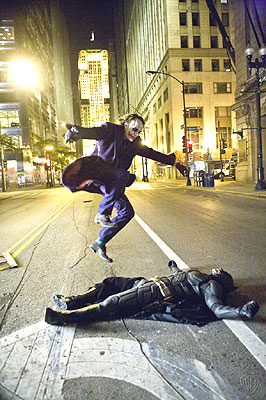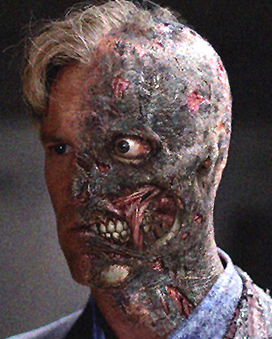The Abyss Gazes Into Thee: Batman, The Dark Knight, and Modern Gothic
Published on September 29th, 2008 in: Books, Comics, Halloween, Horror, Issues, Movies |Much as Bruce Wayne created Batman, so does Dr. Frankenstein create his creature, which becomes an extension of his ego as it represents the culmination of a life of studying the “ancient teachers” of natural philosophy (much as Bruce Wayne learned the origins of his Batman “craft” from the ancient society, the League of Shadows). (13) His ego beckons the Doctor into a life of deceit as he takes great pains to hide his experiments from friends and family, even after the creature he creates eventually escapes.
“Frankenstein, at root,” says Punter, “is a book about the rejection of the strange, at both social and psychological levels.” (14) And who could personify this more than The Joker who cackles, “Whatever doesn’t kill you simply makes you stranger.” No matter how much Batman may reject The Joker (or himself, for that matter), The Joker insists that, “you and I are destined to do this forever.”

Such a struggle brings to mind Punter’s statement that Frankenstein “. . . concludes with the [Doctor and his creation] locked in a perpetual mutual pursuit and conflict.” (15) This mutuality is not limited to their conflict but to their very existence, as they are two versions of the same being. The Joker swears he doesn’t want to kill Batman—”you complete me”—and declares Batman is equally insane: “Madness, as you know, is like gravity. . . all it takes is a little push!” Their ongoing battle is “what happens when an unstoppable force meets an immovable object,” and one which presumably takes place on Punter’s “borderland.”
This kind of battle can also be found in Robert Louis Stevenson’s Dr. Jekyll and Mr. Hyde. Punter asserts “Hyde is not Jekyll’s opposite, but something within him.” (16) and notes “[t]he split in his being has derived much less from the presence within his psyche of an uncontrollable, passionate self than from the force with which that self has been repressed according to the dictates of social convention.” (17)
While one might seek to apply this idea to Bruce Wayne and Batman, it’s a more accurate description of another of The Dark Knight‘s doubles, Harvey Dent, who was nicknamed “Two-Face” during his stint in the Internal Affairs Bureau, where he exposed rotten cops. We see evidence of Harvey’s repressed self in the courtroom when he grabs the gun from the thug on the stand and when he flips a coin to play Russian Roulette with one of the Joker’s henchmen. Batman stops him, asserting that, “if anyone saw this, everything would be undone—all the criminals you got off the streets.” Thus the dictates of social convention have won, albeit temporarily.

In fact, Harvey doesn’t give in to that “something” within himself until after his physical self has been “split” by his burned face. “You either die a hero,” says Harvey, “or you live long enough to see yourself become the villain.” These two sides of one coin are also visually represented in Harvey’s lucky coin, which he flips to make important decisions. The coin appears to resemble Janus, the two-faced Roman god who was “representative of the middle ground between barbarity and civilization.” (18)
Janus was also “the god of gates, doors, doorways, beginnings, and endings,” which evokes the idea “the doors of perception.” (19) This term originally appeared in William Blake’s The Marriage of Heaven and Hell, which in its title proposes a joining of opposite forces. (20) As Two-Face, Harvey Dent is able to cross the threshold and satisfy his thirst for what he considers the only “true” morality: chance.
Time limit is exhausted. Please reload the CAPTCHA.